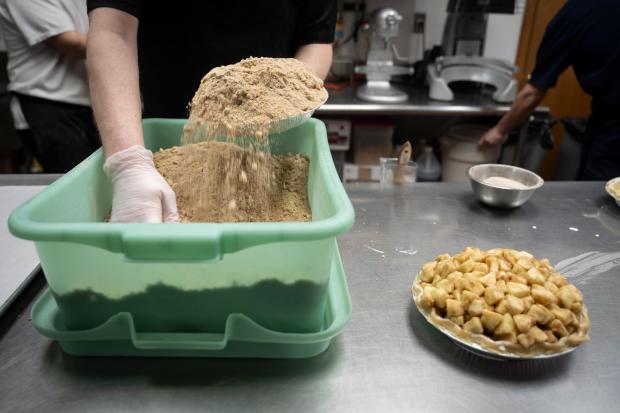By Curt Anderson, Associated Press
Math lovers worldwide, from college students to rocket scientists, celebrate Pi Day on March 14 or 3/14 — the first three digits of a number with many practical uses.
Across the globe, many people will celebrate the day with a slice of pie, whether sweet, savory, or even pizza.

In simple terms, pi is a constant in mathematics that expresses the ratio of a circle’s circumference to its diameter. It is part of many formulas used in physics, astronomy, engineering, and other fields, with roots dating back thousands of years to ancient Egypt, Babylon, and China.
The origin of Pi Day goes back to 1988, when physicist Larry Shaw began celebrations at the Exploratorium science museum in San Francisco. The holiday gained national recognition two decades later. In 2009, Congress designated every March 14 as the big day, aiming to generate more interest in math and science. Interestingly, the day is also Albert Einstein’s birthday.
Here’s more about the holiday’s origin and current celebrations.
WHAT IS PI?
Pi can be used to calculate the circumference of a circle by multiplying the diameter — the distance across the circle’s middle — by the number 3.14 and beyond.

Pi is a constant and it is also infinite, which means it is mathematically irrational. Long before computers, historic scientists like Isaac Newton spent countless hours calculating decimal places manually. Today, with advanced computers, researchers have calculated trillions of digits for pi, but there is no end.
WHY IS IT CALLED PI?
It wasn’t named until 1706, when Welsh mathematician William Jones started using the Greek symbol for the number.

Why that letter? It’s the first Greek letter in the words “periphery” and “perimeter,” and pi is the ratio of a circle’s periphery — or circumference — to its diameter.
WHAT ARE SOME PRACTICAL USES?
The number is crucial for accurately aiming an antenna toward a satellite. It helps determine everything from the size of a massive cylinder needed in refinery equipment to the size of paper rolls used in printers.

Pi is also important in figuring out the required size of a tank that provides heating and air conditioning for buildings of different sizes.
NASA uses pi regularly. It is crucial for calculating orbits, the positions of planets and other celestial bodies, elements of rocket propulsion, spacecraft communication, and even the correct deployment of parachutes when a vehicle lands on Earth or Mars.
By using just nine digits of pi, researchers claim they can compute the Earth’s circumference so accurately that it only makes an error of about a quarter of an inch (0.6 centimeters) for every 25,000 miles (about 40,000 kilometers).
IT’S NOT ONLY MATH, THOUGH
Each year, the San Francisco museum that created the holiday hosts events, including a parade around a circular plaque, known as the Pi Shrine, 3.14 times — and then, of course, celebrations with plenty of pie.

Across the nation, numerous activities now occur on college campuses. For instance, Nova Southeastern University in Florida will organize a series of activities, including a game called “Mental Math Bingo” and an event with free pizza (pies) — and for dessert, the required pie.
“Every year Pi Day gives us a way to celebrate math, have some fun, and acknowledge how important math is in all our lives,” declared Jason Gershman, chair of NSU’s math department.
At Michele’s Pies in Norwalk, Connecticut, manager Stephen Jarrett said it’s one of their busiest days of the year.

“We have hundreds of pies going out for orders (Thursday) to companies, schools, and just individuals,” Jarrett said in an interview. “Pi Day is such a fun, silly holiday because it’s a mathematical number that people love to turn into something fun and something delicious. So people celebrate Pi Day with sweet pies, savory pies, and it’s just an excuse for a little treat.”
NASA has its annual “Pi Day Challenge” online, offering people plenty of games and puzzles, some of them directly from the space agency’s own playbook such as calculating the orbit of an asteroid or the distance a moon rover would need to travel each day to survey a certain lunar area.
WHAT ABOUT EINSTEIN?
Possibly the most famous scientist in the world, Einstein was born on March 14, 1879, in Germany. The infinite number of pi was utilized in many of his groundbreaking theories and now Pi Day provides another reason for celebrating his accomplishments.

In an interesting coincidence, well-known physicist Stephen Hawking passed away on March 14, 2018, at age 76. Nevertheless, pi is not a perfect number. He once expressed this idea:
“One of the fundamental rules of the universe is that nothing is perfect. Perfection simply doesn’t exist. Without imperfection, neither you nor I would exist.”
Associated Press video journalist John Minchillo contributed from Norwalk, Connecticut.









